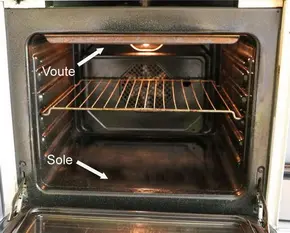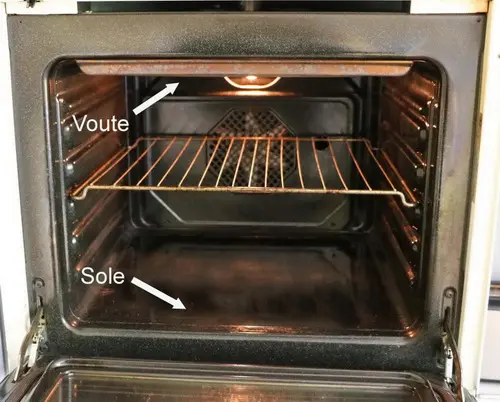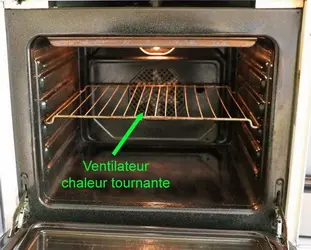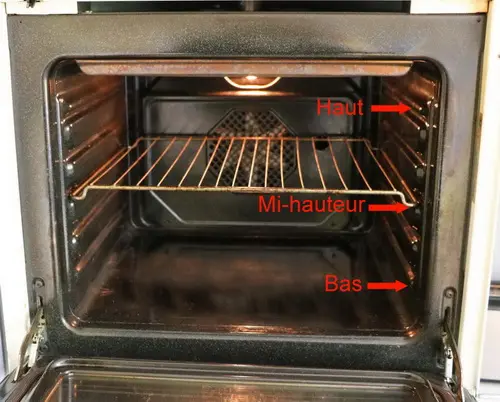Kitchen ovens

You certainly have one in your kitchen, an oven, the essential tool for all kinds of cooking, whether in the kitchen of course, but also in pastry, bakery, pizza, and many others.
Here is some information on its structure and operation.
Here is some information on its structure and operation.
33 K 4.4/5 (17 reviews)
Keywords for this post:OvenCookingTemperatureUseTipsLast modified on: May 16th 2020
Kitchen ovens
What is an oven?
It is a cooking method, as old as cooking, which consists in cooking food without direct contact with the heat source (as on a stove for example), but in a closed and heated enclosure.How does it work?
We are talking here about an electric oven, they are made of a square steel enclosure, thermally insulated, which closes with a tight door, often glazed.
The top of the oven is called "the vault" ("voute" in french), the bottom "the sole".
There is an electric resistance under the roof (often visible) and another one under the bottom (invisible), these two resistances when they receive electric current transform it into heat, it is what makes your oven heat up.
Normally one use the 2 resistors, to heat on the top and the bottom, but sometimes we need to heat only on the top, to make gratin, it is called the "grill" position, and in this case only the top resistor is heated and often at maximum power.
Here is the general principle: a closed and insulated enclosure, and 2 heating elements to heat the inside.
Improvements

More recently, there is also "pulsed heat", in this system the internal fan, which is always present, has its own heating resistor which delivers heated air, instead of stirring the air in the oven. Preheating and baking time is further reduced.
Lighting
ovens are lit, more or less well, and in the basic version, it's a simple small incandescent bulb (like a fridge lamp) that lights up the interior rather poorly. We have to admit that the lighting is rather average.The first improvement is that the lighting moves towards the vault, and is transformed with a halogen bulb. It's much more efficient.
The next improvement will see ovens equipped with leds, giving a powerful and regular light. This is already available at the time of writing (May 2020), but for the moment only in the higher end ovens.
The position in the oven

This position allows you to adjust a little where you want the heat to have the most effect:
- To put at the bottom, means that we want to insist on the bottom of the dish to cook it more (example a pie)
- Putting it on the top means that you want to put more heat on the top of the dish to cook it more (example a gratin)
- Putting it in the middle means that you want the dish to be cooked in a classic way, without any particularities.
What to choose?
There are many possibilities: rotating heat or not, position in the oven, temperature...Don't worry, with cooking-ez.com it's simple: if a special oven configuration is needed for a recipe it will be expressly indicated. And if not, always opt for "rotating heat" (if you have it) and position of the rack "halfway up".
Lasts posts
Oven height
When we put a dish or cake in the oven, we naturally tend to put it on the middle shelf, and that's what we usually do. But in some cases, this position and height can be a little tricky, so let's find out why.October 8th 20255355
The importance of sieving
In recipes that use a fine powder (flour, powdered sugar, etc.), you'll often see the advice to sift before using it. To sift is to pass the powder in question through a sieve (a very fine strainer) before incorporating it into your recipe. It's often advice, but is it really useful?September 3rd 20256,5633
The grease spray
As soon as you have something in a recipe that sticks to the mold, the question always arises as to how difficult it is to remove from the mold. There's nothing more frustrating than breaking your cake when unmolding it, because part of it has stuck in the mold. The classic way to avoid this is...August 26th 20255,9675
Cake moulds
When we make a cake, or a cake of the same rectangular shape, we usually take out our usual mould and tell ourselves that the recipe is anyway "for a cake", but is it really that simple?August 25th 20256,1645
Thinning out herbs
If you need to add a long-stemmed herb (tarragon, mint, verbena, thyme, etc.) to a recipe, you'll probably only need the leaves and not the stem, so you'll need to remove the leaves. Leaf removal means keeping only the beautiful leaves, and eliminating the ugly stems and leaves, but how do you do...August 8th 20254,3355
Other pages you may also like
The importance of sieving
In recipes that use a fine powder (flour, powdered sugar, etc.), you'll often see the advice to sift before using it. To sift is to pass the powder in question through a sieve (a very fine strainer) before incorporating it into your recipe. It's often advice, but is it really useful?September 3rd 20256,5633
For well opened (puffed) cakes
It's always nice to have a well puffed up cake after baking, not only will it taste good but it looks great too. Let's see how to get this beautiful shape almost every time.January 23th 201934 K4.2
Sausage broth
I've already talked to you about vegetable cooking water, which becomes a precious broth after cooking that would be a shame to throw away. Now let's look at the special case of meat cooking broth, and in particular sausages, which are often poached.June 28th 202311 K5
A few tips for effective kneading at home
When you have to knead dough for bread or some other recipe, you may well use a food processor or the type of machine known as a stand mixer. The best-known brands are Kenwood and KitchenAid. They are useful tools, but here are a few tips to help you get the best out of them.June 23th 2021282 K 23.7
Drawing a pattern in pastry
Often in the kitchen, in pastry-making, or in baking, we need to trace a pattern on a pastry. It's just a question of aesthetics but it has its effect after baking on a galette, pithiviers, pâté en croute (terrine in a pie crust), etc.May 23th 201934 K4.1
Post a comment or question
Follow this page (as 3 people already do)
If you are interested in this page, you can "follow" it, by entering your email address here. You will then receive a notification immediately each time the page is modified or a new comment is added. Please note that you will need to confirm this following.
Note: We'll never share your e-mail address with anyone else.
Alternatively: you can subscribe to the mailing list of cooling-ez.com , you will receive a e-mail for each new recipe published on the site.








